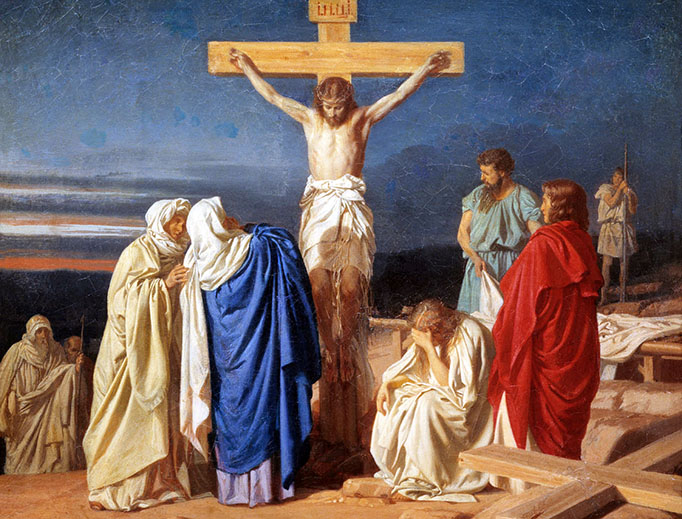The World is in Rebellion and the Church is at the Cross
Here we are at the cross. What is the Lord asking of you?

During Eastertide we reflect on the afterglow of the resurrection and the first weeks of the Church, bathed in the joy of Pentecost and the evidence of miracles and growth. But in the liturgy, we also read from the Acts of the Apostles: of persecutions, of the jailing of Peter and Paul, and even of internal struggles with the deception of Ananias and Saphira. Even as the Church was struggling to “get up to speed,” there were roadblocks and internal disagreements. Acts goes on to describe even greater storms in the future, as the debate over Gentile converts heated up.
The Church has seldom found a period free of these competing realities: resurrection life mingled with the difficulties of living in a fallen world, governed by a fallen angel, and we with fallen natures. Regarding the Church, there is this saying: Ecclesia semper reformanda (The Church is always in need of reform). Hence, the cross.
We often wonder why the Lord seems to keep us near the cross. Both as individuals and as a Church we have frequent periods of difficulty and discouraging setbacks. In our times we lament the collapse of Christendom and bemoan the fact that even within the Church there are grave divisions and uncertainty. Some of us older Americans remember the last vestiges of Christendom and recall a time that, while not sinless, seemed more orderly and organized around Christian ideals, even if imperfectly lived. The Church, too, seemed more certain and orderly. But even in those postwar years of huge Catholic parishes and strong cultural ties there were rifts just beneath the surface. Already, Europe had descended into the current winter of disbelief; atheism, communism, and secularism were on the rise. The lights of Christendom were going out in Europe long before the cultural revolution of the late 1960s in the U.S.
After this and through the confusion of the 1970s and 1980s, even rebellion was widespread throughout the Church. By the 1990s, some of us who are more traditional had a sense that the Church was, perhaps, recovering her bearings. The publication of the Catechism and the strong and vigorous engagement of the culture by Pope John Paul II—with his confident and joyful assertion of doctrine—gave the sense that we might be emerging from a long period of uncertainty and retooling. Recent years, though, have seen the surfacing old rifts; the Church seems once again plagued with divisions at the highest levels. Some of us feel uncertain; the clarity for which we long seems obscured by both the remarks of some of our shepherds and the silence of others.
So, we are once again at the cross. Apparently, the Lord sees need of further purification for each of us and for the Church.
The cross may often dismay us. We may wonder at God’s ways, but we should also recall that the cross was not God’s original plan. He first offered us paradise, if we would trust Him and not insist on the knowledge of good and evil for ourselves. Adam and Eve rejected trust and preferred pride. They made that choice knowing that suffering and death would be the result. Each of us has ratified that decision on countless occasions, and the Lord does not set aside our choice. He takes us seriously and does not merely overrule our decision as the choice of fools. Neither did he cast us away. He meets us at the cross, at the corner of suffering and death, at our decision point. This is where He does His deepest work.
If, then, we are at the foot of the cross, perhaps we should act that way. It is easy to complain, and speaking out against error is important, but we who are concerned about the state of the Church might consider something more than lamenting or decrying the condition of things. At the foot of the cross we must suffer with the Lord for the sake of the Church. Now is a time to multiply our prayers by being more faithful to the Rosary and adding the Divine Mercy Chaplet. The Lord may be calling us to fasting and abstinence beyond the mere requirements of Lent. Perhaps He is calling us to Eucharistic adoration, increased visits to our church, or attendance at daily Mass. In addition, we must attend to our own sins more seriously. Perhaps there is one sin or sinful attitude that we can curb by God’s grace.
Here we are at the cross. What is the Lord asking of us but that we join Him in His redemptive work for the Church, His Body and His Bride? What is the Lord asking of you?
Archbishop Fulton Sheen noted the countless efforts to reform the Church (committee meetings, local and worldwide synods, blue-ribbon panels, “renewal programs”), but lamented that there was one thing no one dared try: holiness.
In these times as well, we must speak out and express our concerns for the condition of the Church and her leaders, but if we do not couple our concerns with the cross and with whatever the aspect of the cross the Lord asks of us, we risk being mere complainers who bring more heat than light.
We are at the cross; most of us know that. What sliver of the cross is yours?













